The seven essential control safeguards you'll need for your yearly evaluation include rigorous equipment calibration testing, extensive documentation management, detailed personnel training records, systematic environmental monitoring, thorough access control verification, robust emergency response planning, and meticulous compliance audit reporting. You'll want to guarantee your equipment meets calibration standards, maintain secure document storage with version control, track staff training effectively, monitor environmental conditions regularly, verify access permissions systematically, establish clear emergency procedures, and document all compliance activities. These fundamental safeguards form the foundation of a strong control system, and understanding their interconnected nature will strengthen your evaluation strategy.
Equipment Calibration and Testing Protocols
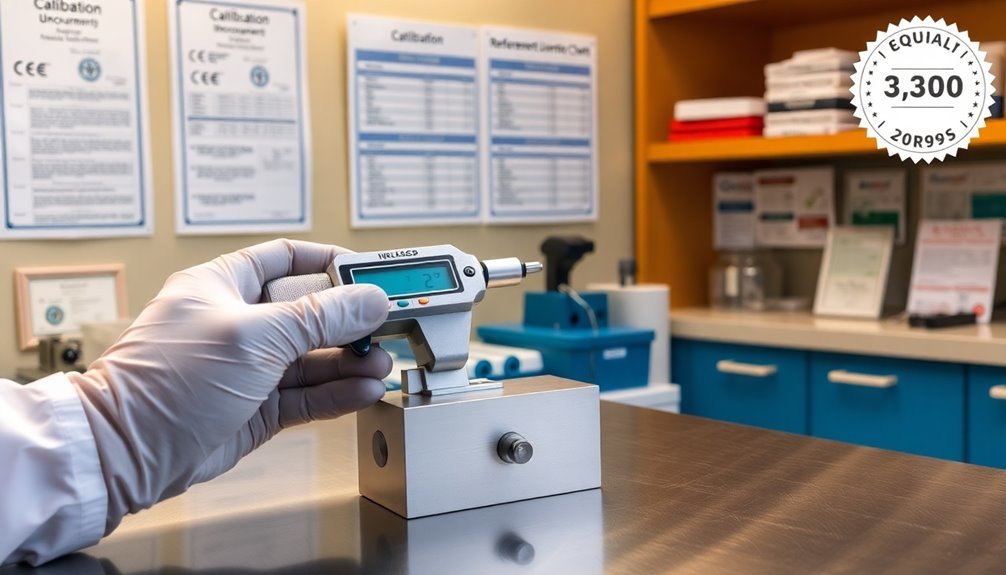
You'll find that proper equipment calibration forms the backbone of reliable testing and measurement systems. To maintain accuracy and precision, you'll need to guarantee your calibration standards are traceable to national or international benchmarks. When these aren't practical, use independent reproducible standards that meet industry requirements.
Your calibration schedule should typically follow an annual cycle, though critical measurement devices may need more frequent attention. Prioritizing critical and non-critical machinery helps establish effective calibration timelines. It's essential you follow manufacturer recommendations for specific equipment and implement automatic recall procedures to stay on track.
You'll want to document all calibration dates and results thoroughly, as this documentation is vital for quality control and compliance. Remember to maintain calibration standards that are at least four times more accurate than the devices you're calibrating.
You'll need to incorporate safety protocols into your calibration procedures and guarantee your testing meets ISO 9001 and ISO/IEC 17025 requirements. When calibration results fall outside acceptable limits, implement corrective actions immediately.
Consider using a Calibration Management System (CMS) to streamline your processes and maintain consistent quality control throughout your testing procedures.
Documentation Management Systems
Building on proper equipment calibration practices, a robust documentation management system safeguards your organization's data and processes.
You'll need to implement secure storage, version control, and role-based access controls to protect sensitive information while guaranteeing seamless collaboration among team members.
To maintain effective documentation management, you'll want to focus on these critical elements:
- Set up automated workflows that streamline document-related tasks, reducing manual effort and increasing productivity while maintaining consistent processes.
- Implement cloud-based solutions that provide anywhere-access to your documents while guaranteeing robust backup and recovery options.
- Enable version control features to track changes, maintain document history, and prevent confusion over multiple document versions.
- Establish audit trails and compliance tracking to meet regulatory requirements and maintain accountability.
Your system should integrate smoothly with existing business tools and scale as your organization grows. A centralized document system significantly improves review efficiency and overall document management effectiveness.
Don't forget to conduct annual reviews of your documentation system to guarantee it's meeting your needs and keeping pace with technological advances.
Personnel Training Records
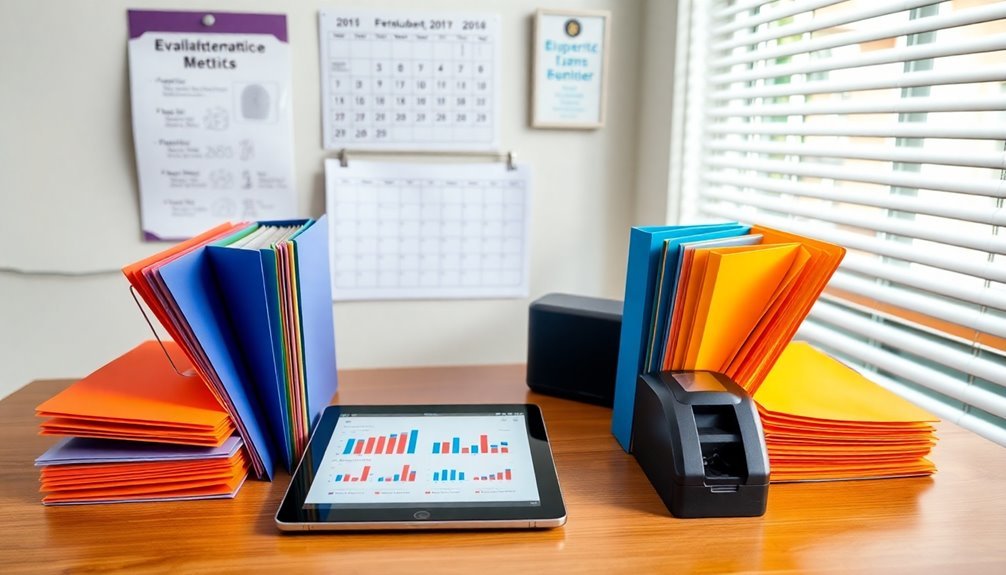
Personnel training records serve as the backbone of your organization's compliance and quality management system. To maintain regulatory compliance and demonstrate employee competence, you'll need to move beyond spreadsheet-based tracking and implement a robust training record management system. You'll find these systems support closed-loop CAPA processes for effectively addressing any identified training deficiencies.
Modern cloud-based solutions offer automated tracking, real-time reporting, and customizable requirements that align with your organization's needs. You'll find these systems particularly valuable during audits, as they provide thorough audit trails and guarantee you're meeting ISO standards.
| Feature | Benefit |
|---|---|
| Automated Tracking | Reduces administrative time and eliminates manual errors |
| Real-time Reporting | Identifies training gaps and guarantees compliance instantly |
| Customizable Requirements | Adapts to specific job roles and organizational needs |
| Audit Trail Capability | Documents all changes and supports regulatory compliance |
To maximize the effectiveness of your training records, you'll want to focus on system features that support employee development while maintaining compliance. Consider solutions that offer user accessibility for employee self-service, cost management tracking, and scalability for organizational growth. These features won't just satisfy auditors – they'll provide valuable insights into training effectiveness and help drive continuous improvement in your workforce development programs.
Environmental Monitoring Procedures
Environmental monitoring procedures form a vital foundation for maintaining safe and compliant facilities. You'll need to implement thorough sampling methods and establish clear protocols for monitoring potential contamination points throughout your facility.
It's critical to combine multiple sampling approaches, including viable and non-viable particle monitoring, along with strategic use of settle plates and active air samplers.
To guarantee your monitoring program's effectiveness, you must:
- Create detailed facility maps that identify vital sampling locations and high-risk areas where contamination is most likely to occur
- Establish systematic swabbing patterns using appropriate tools like sponges for large surfaces and cotton-tip swabs for narrow spaces
- Incorporate neutralizing agents in your sampling materials to prevent interference from residual disinfectants
- Document and review your sampling frequency and duration based on risk assessments
You'll need to conduct annual reviews of your environmental monitoring plan to maintain its relevance and effectiveness.
Many organizations utilize proven software solutions to streamline their compliance assessment processes and maintain accurate monitoring records.
Don't forget to assess any new services or programs added since your last evaluation, and always update your protocols when new hazards are identified.
Remember that proper documentation of sampling locations and results is fundamental for regulatory compliance and continuous improvement.
Access Control Verification
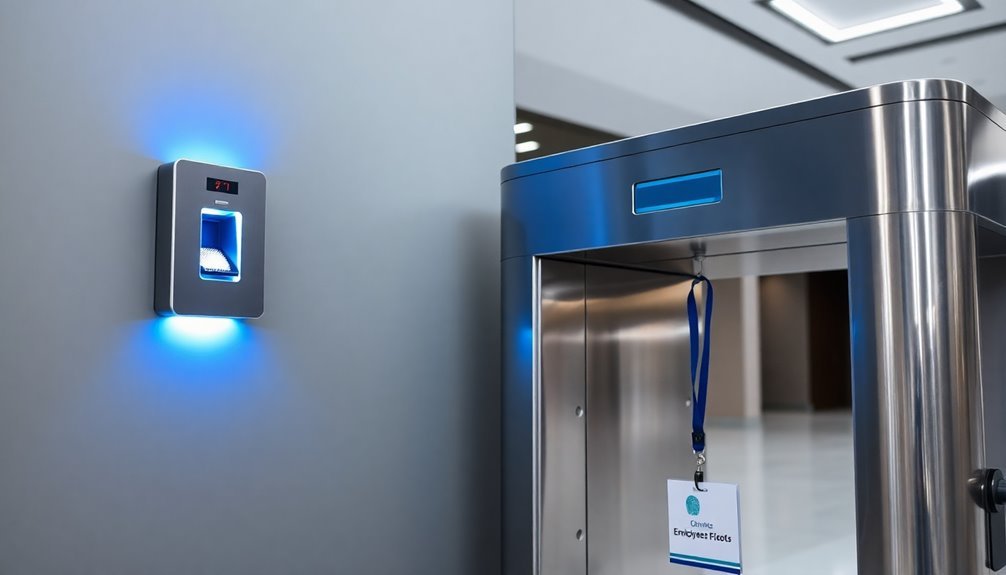
Throughout the year, effective access control verification serves as a cornerstone of your facility's security framework. You'll need to understand and implement various access control models to maintain robust security measures. Property management and safety depend heavily on proper access control implementation.
Each model offers distinct advantages: MAC provides stringent control for high-security environments, RBAC simplifies administration through role-based permissions, DAC allows flexibility in user permissions, and RuBAC adapts to specific rule sets.
To strengthen your access control system, you'll want to incorporate multiple authentication methods. Certificate-based authentication uses digital certificates for identity verification, while biometric authentication relies on unique biological characteristics.
You can enhance security further by implementing token-based systems and multi-factor authentication, though you'll need to account for potential issues like lost devices.
When implementing these controls, you'll need to match the model to your security requirements. If you're managing a high-security facility, consider MAC, where system administrators maintain complete control.
For organizations with clearly defined roles, RBAC offers streamlined management. Remember to integrate your chosen access control model with complementary security measures like MFA and biometric systems to create an extensive security framework.
Emergency Response Preparedness
A thorough emergency response plan forms the foundation of your facility's preparedness strategy.
You'll need to carefully assess your available resources and establish clear procedures for various emergency scenarios. Your plan should integrate both internal capabilities and external emergency services, ensuring everyone understands their roles and responsibilities.
Start by evaluating your emergency response preparedness through these essential steps:
- Conduct a detailed assessment of your internal resources, including personnel, equipment, and communication systems, while identifying gaps that external resources need to fill.
- Develop specific procedures for different emergency scenarios, incorporating evacuation routes, shelter locations, and lockdown protocols that align with your facility's layout.
- Establish formal relationships with local emergency services, LEPCs, and contractors, ensuring they're familiar with your facility's layout and hazards. Systematic hazard analysis must involve leadership from all departments to ensure comprehensive evaluation.
- Schedule regular training sessions and drills that include both your staff and external responders, testing your communication systems and response procedures.
Don't forget to document all aspects of your emergency response plan and review it annually.
You'll want to update procedures based on drill results, changes in resources, or newly identified risks to maintain peak preparedness.
Compliance Audit Reporting Methods
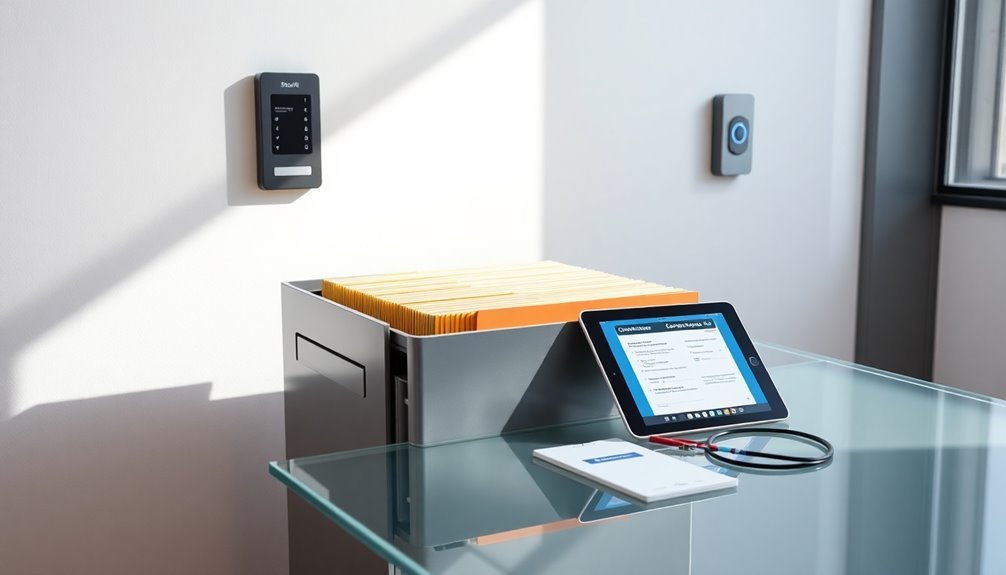
Your organization's compliance audit reporting starts with maintaining thorough digital audit trail records that track all compliance activities and system changes throughout the year.
You'll need to implement real-time compliance monitoring tools to instantly flag violations and automate the documentation of regulatory adherence.
Risk assessment documentation must be systematically organized and regularly updated to reflect emerging threats and your organization's response measures, ensuring a clear path for yearly evaluations. Utilizing audit automation tools helps streamline data collection and minimize potential errors in the documentation process.
Digital Audit Trail Records
Digital audit trail records serve as the backbone of modern compliance monitoring, creating an unalterable chain of documented system activities. These extensive logs track every user interaction, system change, and data modification within your IT environment, providing you with a reliable mechanism for maintaining accountability and security compliance.
Your digital audit trail system should capture essential elements that'll help you maintain strong control over your operations:
- User identification and authentication details, including login attempts, access levels, and permission changes
- Timestamps and chronological sequences of all activities, enabling you to reconstruct events with precision
- Detailed records of modifications made to documents, including version control and change history
- System-generated alerts for unusual activities or potential security breaches
You'll find these trails invaluable for regulatory compliance, especially in finance and healthcare sectors where stringent documentation is mandatory. Time-stamped ledger records provide immutable proof of document integrity and authenticity.
They're your first line of defense in detecting unauthorized access and supporting internal control assessments. When integrated with other control measures, audit trails strengthen your overall security posture and provide significant evidence for investigations or legal proceedings.
Real-Time Compliance Monitoring
Building upon robust audit trail foundations, real-time compliance monitoring takes oversight to the next level by providing immediate insights into your organization's regulatory adherence.
You'll need to implement extensive GRC platforms, SIEM tools, and privacy management solutions that continuously track user activities and automatically enforce policies.
To maximize effectiveness, you'll want to customize your alerts based on specific regulations and company policies while maintaining detailed audit trails. This approach guarantees you're not just collecting data but actively responding to potential compliance issues as they arise. You're also protecting your organization from costly penalties through proactive risk mitigation.
When integrating real-time monitoring with your compliance audits, focus on standardizing your reporting methods and emphasizing high-risk areas.
You'll need to make sure your monitoring data flows seamlessly into audit reports, providing stakeholders with transparent, actionable insights.
Don't forget to leverage automation tools for streamlined data collection and analysis, making your audit process more efficient and accurate.
Risk Assessment Documentation
While conducting yearly evaluations, properly documenting risk assessments forms the cornerstone of effective compliance reporting. Your documentation should follow standardized templates that guarantee consistency and maintain clear communication with stakeholders throughout the audit process.
By implementing a structured approach, you'll create detailed reports that highlight critical findings and drive actionable insights.
To develop effective risk assessment documentation, focus on these essential elements:
- Structure your reports with clear sections outlining the purpose, scope, and methodology used during the assessment, making it easier for stakeholders to understand your findings.
- Detail your risk evaluation criteria, whether you're using a high/medium/low classification or a numeric scoring system, and include the rationale behind your assessments.
- Document all testing methods employed, including substantive, compliance, and control testing, along with supporting evidence for each finding.
- Create a specific action plan that outlines corrective measures, assigns responsibilities, and establishes timelines for addressing identified risks.
Remember to leverage automation tools when possible to streamline your data collection and analysis processes. This approach will help guarantee your documentation remains objective, thorough, and aligned with compliance requirements.
Frequently Asked Questions
How Often Should Security Clearance Levels Be Reassessed for Existing Employees?
You'll need reassessment every 15 years for Confidential, 10 years for Secret, and 5 years for Top Secret clearances. Continuous evaluation happens year-round, and significant life changes trigger immediate reviews.
What Metrics Determine if Segregation of Duties Is Effectively Preventing Fraud?
You'll need to track transaction monitoring results, job role overlap assessments, and compliance audit findings. Regular risk assessments and error detection rates will help you measure if your segregation of duties effectively prevents fraud.
How Can We Measure the ROI of Implementing New Control Safeguards?
You'll measure ROI by comparing costs against quantifiable benefits like reduced incidents, financial savings, and improved efficiency. Track these metrics before and after implementation, then calculate the percentage return on your investment.
When Should Automated Monitoring Systems Be Replaced or Upgraded?
You should replace automated monitoring systems when they fail performance tests, show frequent maintenance issues, can't meet regulatory requirements, become technologically obsolete, or when major process changes occur in your facility.
What Role Should External Consultants Play in Evaluating Internal Control Effectiveness?
You'll want external consultants to provide unbiased assessments, specialized expertise, and industry insights. They can identify risks you've missed, offer advanced tools, and guarantee compliance with regulatory requirements through independent evaluations.
In Summary
You've got all the essential control safeguards to make your yearly evaluation robust and reliable. By implementing proper equipment calibration, documentation systems, training records, environmental monitoring, access control, emergency response, and compliance auditing, you're setting yourself up for success. Don't forget to regularly review and update these safeguards to maintain their effectiveness and keep your facility running smoothly.

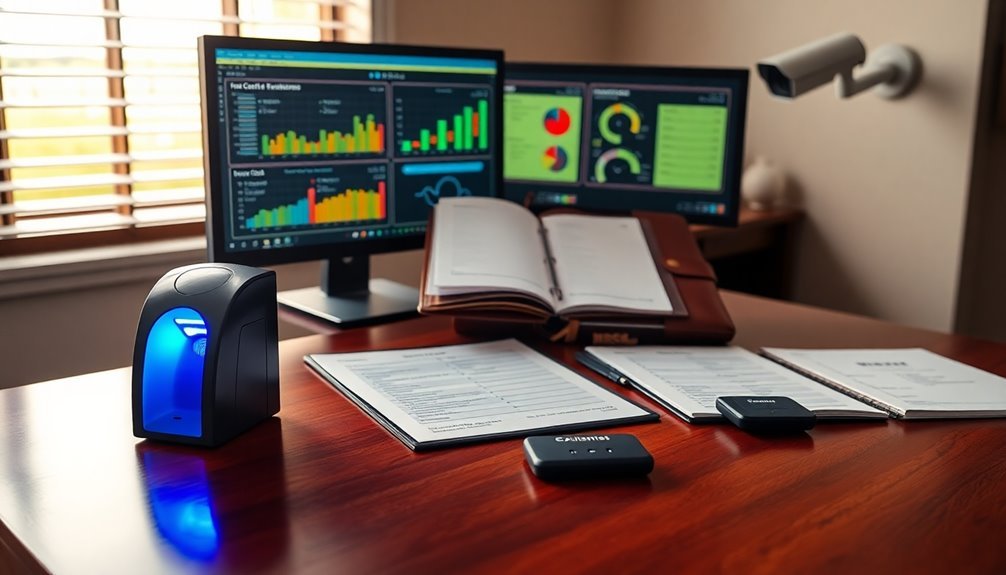



Leave a Reply